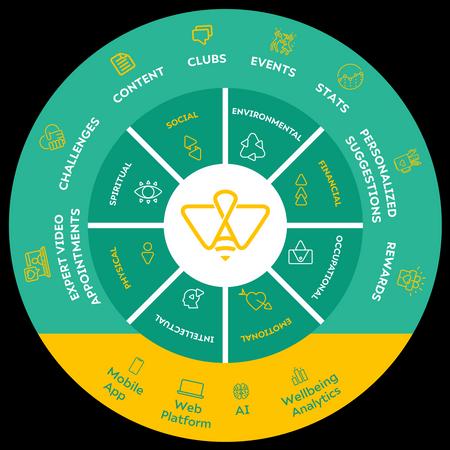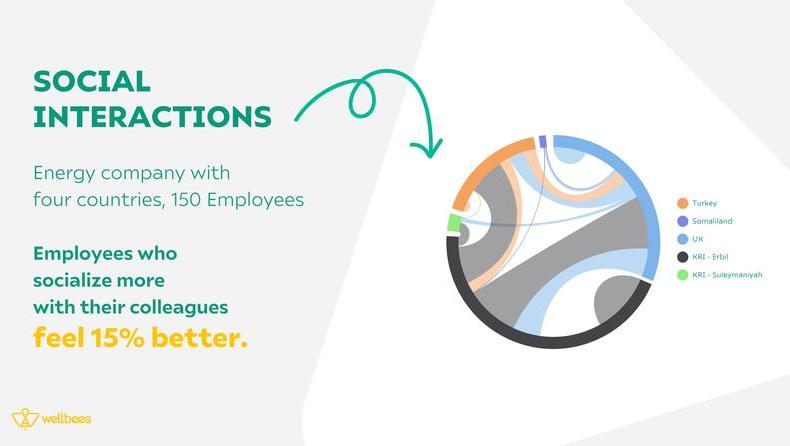When planning for wellbeing interventions, think social!
Several decades ago, Hackman and Oldham (1976, 1980) an economist and a psychologist, created a model called Job Characteristics where task significance – the degree to which an employee’s work affects the health and wellbeing of other people – is seen as an important aspect of a ‘great’ job, as it creates meaning and rationale for employees. Such tasks trigger autonomous work motivation by enabling employees to experience meaningful work. Sometimes this has a more positive affect, beyond even money for happiness and satisfaction. A recent HBR article found that more than nine in 10 employees are willing to trade a percentage of their lifetime earnings for greater meaning at work.
Yet the question remains: Is that enough? Can we be satisfied enough based solely on purpose?
We see in our research that social connectivity needs to be added to that mix. Often connection is ignored for the sake of professionalism, emotions are buried for the sake of task-orientation, relationships are postponed for the sake of productivity, and playfulness is undermined for the sake of seriousness. However, a growing body of research suggests that interpersonal relationships play a key role in the extent to which employees experience their work as important, meaningful and remain engaged at work (Ryan & Deci, 2017; Barry & Crant, 2000; Bradbury & Lichtenstein, 2000; Wrzesniewski, Dutton, & Debebe, 2003). Therefore, solely designing meaningful tasks as the building blocks of jobs and mastering them is not enough for a flourishing work experience.
There is a dichotomy between seriousness and playfulness; where purposefully saving the world is serious work for adults, and savouring the world is playful work for kids. “I arise every morning torn between the desire to improve the world and the desire to enjoy it. This makes it hard to plan the day,” said E.B White, putting this dilemma into words.
Likewise, the findings of a study by Adam Grant (2008) shows us that it is not one or the other but both which motivates employees to act and accomplish effectively. In other words, employees who experience the desire to both improve and enjoy the world persist more, perform better and have higher productivity.
The need to achieve playfulness through social connections
Identity is an umbrella concept in psychology that elaborates people’s responses to the question “Who am I?” (Stryker & Burke, 2000). This is one of the simplest and hardest questions on earth. Whatever our answer is to this question, we have one thing in common. We need this identity to be autonomous, capable and relational. Among our many different identities, our employee identity also encapsulates these three needs.
Psychologists provide evidence that people have basic motives to experience their identities in terms of autonomy, or experiencing the self as internally directed; competence, or observing the self as capable; and social worth, or savouring the self as related and valued in interpersonal bonds (Ryan & Deci, 2000, 2001). Here, it is important to highlight that some organisations fail to recognise the need for relationships. They rather only focus on boosting the individuals’ competence and autonomy to attain playfulness. However, true competence and autonomy can only be sustained via interpersonal contexts and supportive encounters.
Therefore we can say, social bonds are the catalyst for that desired intrinsic motivation and performance. With respect to self-determination, because employees feel that their own actions are affecting others, and because they feel personally responsible for the choice to expend greater effort, persistence and social behaviour, they are likely to experience their actions as self-determined, which is intrinsically rewarding and pleasing to the self within social relationships (Ryan & Deci, 2017). This is what we aim at work: being sociable, capable and joyful individuals.
How to achieve playfulness through social connections
Let’s consider a recent article from McKinsey Health Institute to find out how to achieve playfulness through social connections. It found that nine out of 10 companies offer some form of employee wellbeing in their workplace. However, as McKinsey rightfully states: “we often think of employee mental health, well-being, and burnout as a personal problem. That is why most companies have responded to symptoms by offering resources focused on individuals such as wellness programmes. However, employers can and should view high rates of burnout as a powerful warning sign that the organisation – not the individuals in the workforce – needs to undergo meaningful systematic change.”
At Wellbees, we could not agree more. Prof. Greenberg from King’s College has a wonderful quote that belongs exactly here. He says: “resilience is not within the individual but in the bonds between them.” Hence, social connections not only complement the purpose to create a playful and a balanced workplace, but also in offering one that has wellbeing in its core.
In our work as Wellbees, we never plan only for the individual when designing for behaviour change, since it will never create a sustainable organisational one. Only when we apply multiple layered interventions can we get the results that have a ripple effect within the workforce. Evidence comes from group dynamics and group psychotherapy literature: Group is a motivational background for change, even for an individual change. Self-work cannot be done alone. We need mirrors to reflect us and doubles to witness and accompany us in our wellbeing journey.

This also shows itself in our wellbeing analytics. When you look at companies with lower social scores i.e. those with fewer communication lines between them. You see a consistently higher turnover rate. On the flipside, in those companies with higher social scores, employees tend to be 10% happier at work. Another McKinsey article lends support to this. It found the most important factors to why employees are leaving their jobs in record numbers were social and psychological, including not feeling valued by their organisation or manager, or not having a sense of belonging at work.

How can you plan for change to embrace a social wellbeing approach?
- Daniel Kahneman in Thinking, Fast and Slow argues that the human brain tends to look at the negatives and tries to learn from them. However, you can only learn not to fail by looking at the examples and not the other way around. You can only mimic success by looking at the better case studies. So, what are some of the highest performing groups within your organisation? What are they doing differently in terms of social interaction? Can you get the unit leader to “reveal” their secrets?
- When planning for wellbeing interventions, think social. Can you get the GEP that only works on an individual level to do work like workshops or step challenges with you to multiply the effect?
- Do you know that many employees hate team building practices as they are mostly volunteered/told to attend without consideration of their social contexts and psychological needs? Creating a socially responsive and inclusive team is not merely bringing people together. It is about bonding people with meaningful tasks, via mutually supportive relationships, where each can truly be who they are while being connected to each other at work.
- Try an analytic approach to mapping/measuring social relationships within your organisation. You cannot manage what you cannot measure, is well said by Peter Drucker. Likewise, as an authority in the health domain, CDC provides organisational wellbeing metrics that have features around the social aspect of work, including: the support received by co-workers, experiencing belonging at work, availability of support outside of work, trust to colleagues, and so forth.
- Make every interaction count: All Turtles is a fully distributed company that calls its meetings “Turtle Crossings'' and cutely posts them on their channels. Add some playfulness into your social sauce.
- Implement a strategy where having fun together and being serious together are totally compatible, and indeed a part of your company culture.
- Remember that the desire to improve the world via business and the desire to savour the world can only come via focusing on social wellbeing.
Supplied by REBA Associate Member, Wellbees
We're committed to raising the bar for employee wellbeing. It's about time you join us.








